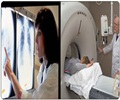DALLAS – Dec. 16, 2009 – Aided by next-generation DNA sequencing technology, an international team of researchers has gained insights into how more than 60 carcinogens associated with
Aided by next-generation DNA sequencing technology, an international team of researchers has gained insights into how more than 60 carcinogens associated with cigarette smoke bind to and chemically modify human DNA, ultimately leading to cancer-causing genetic mutations.
In a new study available online and in a future issue of the journal Nature, lung-cancer experts in the Harold C. Simmons Comprehensive Cancer Center at UT Southwestern Medical Center worked with scientists from the Cancer Genome Project in the United Kingdom to determine the entire genetic sequence of cancer cells from a patient with small-cell lung cancer (SCLC). They then compared those results with normal DNA isolated from the same patient.Using new DNA sequencing technology called "massively parallel sequencing," the researchers searched the DNA sequences for differences between tumor and normal cells. They found more than 23,000 mutations that the tumor cells had acquired and also discovered a new gene involved in lung cancer named CHD7.
The number of mutations from the study suggests that a person may develop one mutation for every 15 cigarettes smoked, said Dr. John Minna, director of the Nancy B. and Jake L. Hamon Center for Therapeutic Oncology Research at UT Southwestern and one of the authors of the new study.
The researchers said the findings illustrate the power of advanced technology to provide important new information about human cancer, including the effect of cancer-causing chemicals on the body and the identification of potential new therapeutic targets.
"Cancer is driven by acquired mutations in genes, and we are at a point where it soon will be possible to actually know every mutation in the tumors of each of our patients," Dr. Minna said.
"The key will be to use this information to find new ways to help prevent cancers, diagnose them earlier and to select treatments that might be specific for each patient's tumor. While these findings are the first step, they have lighted our path to clearly point us in the right direction. In addition, they provide the first detailed analysis of a human cancer – lung cancer – that is closely linked to smoking."
Advertisement
When the researchers analyzed the 23,000 mutations, they found distinctive patterns associated with the cocktail of carcinogens present in cigarette smoke. The DNA sequence of the cancer cells also revealed that the cells had attempted to repair their smoke-damaged DNA using two mechanisms, but the cells were only partially successful.
Advertisement
"By applying the same approach to other cancers not associated with cigarette smoking, including the very large group of people who develop lung cancer but have never smoked, it may be possible to discern which carcinogens play a role in those other cancers as well," Dr. Gazdar said.
Dr. Minna added that the research methods used to analyze the cancer cells represented a technological tour de force.
"The data demonstrate the power of whole-genome sequencing to untangle the complex mutational signatures found in cancers induced by cigarette smoke," Dr. Minna said. "In addition, the protein product of the CHD7 gene now becomes a new marker for early diagnosis and also for potentially targeted therapy."
Source-Eurekalert
TAN















